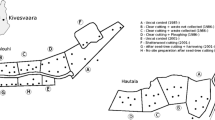Abstract
The occurrence and development of riparian forests which are mainly dominated by mesophytes species relate closely with surface water. Since there is no water discharge to the lower reaches of Tarim River in past 5 decade years, the riparian forests degrade severely. Based on the analyses of the monitored data of Yingsu, Argan and Luobuzhuang in 2002 and 2003, the effect of water-recharging is discussed. The water-recharging project neglects the fact that that it is flooding that controls the process of Populus euphratica colonizing on the bare surface, but focuses on groundwater influence on vegetation. The flooding control deviates inherent laws of riparian forests development, so the natural regeneration of riparian forests is checked. The response scope of riparian plants on groundwater uplift is extremely narrow, and most riparian communities have not been optimized. No seedlings of dominant species are found in flooding areas because their physio-ecological characteristics are ignored. The vegetation changes in vicinities of stream only reflect the demand of mesophytes species on the shallow groundwater, however, the water-recharging fails to provide suitable habitats for the seedlings establishment of riparian plants. The present water-recharging scheme is difficult to realize vegetation restoration.
Similar content being viewed by others
References
Qin R C. Some questions about Populus euphratica and Populus pruinosa. In: Murzayet E M, Zhou L S, eds. Xinjang Natural Environments (in Chinese). Beijing: Science Press, 1959. 173–198
Tian Y Z. Preliminary study on occurrence, distribution and growth features of natural Populus euphratica in the Taklimakan Desert. In: Harness Sand Team of CAS, eds. Harness Desert Research, No. 7 (in Chinese). Beijing: Science Press, 1965. 35–43
Wang S J, Chen B H, Li H Q. Forest of Populus euphratica (in Chinese). Beijing: China Enviornmental Science Press, 1995. 29–36
Zhang L Y, Xia Y. The vegetation and its utilization in the southern fringe of the Taklimakan Desert. Arid Zone Research (in Chinese), 1997, 14(3): 16–22
Wang R H, Wang X W, You X X, et al. Analysis on the structure of the desert riparian forest ecosystems. Arid Zone Research (in Chinese), 2002, 19(2): 7–11
Integrated Study Team to Xinjiang Weger Autonomous Region, CAS. Vegetation in Xinjiang and Its Utilization (in Chinese). Beijing: Science Press, 1978. 178–183
Zhang Y M, Chen Y N, Pan B R. Distribution and floristics of desert plant communities in the lower reaches of Tarim River, southern Xinjing, People’s Republic of China. Journal of Arid Environments, 2005, 63: 772–784
Ma J Z, Zhu Z H, Li J J. The role of groundwater in the fragile ecology in the south of Taklimakan Desert. Journal of Lanzhou University (Natural Sciences) (in Chinese), 2000, 36(4): 88–95
Ji F, Ma Y J, Fan Z L. Soil water regime in Populus euphratica forests on the Tarim River alluvial plain. Acta Phytoecologica Sinica (in Chinese), 2001, 25(1): 17–21
Chen Y N, Zhang X L, Zhu X M, et al. Analysis on the ecological benefits of the stream water conveyance to the dried-up river of the lower reaches of Tarim River, China. Sci China Ser D-Earth Sci, 2004, 47(11): 1053–1064
Xu H L, Chen Y N, Yang G. Effect of translating water on vegetation at the lower reaches of Tarim River. Environmental Science (in Chinese), 2003, 24(4): 18–22
Li W H, Chen Y P, Zhang H F, et al. Response of vegetation to water input at lower dry Tarim River. Journal of Desert Research (in Chinese), 2004, 24(3): 301–305
Xu H L, Chen Y N, Li W H. Study on response of groundwater after ecological water transport at the lower reaches of the Tarim River. Research of Environmental Sciences (in Chinese), 2003, 16(2): 19–38
Song Y D, Fan Z L, Lei Z D, et al. Research on Water Resources and Ecology of Tarim River (in Chinese). Urumqi: Xinjiang People’ Press, 2000, 215–240, 395–410
Wang R H, Fan Z L. Evolution patterns of sandy desertification in the lower reaches of Tarim River Basin in recent 5 decades. Journal of Desert Research (in Chinese), 2000, 20(1): 45–50
Zhao W Z, Chen G D. Ecohydrology—A science for studying the hydrologic mechanisms of ecological patterns and processes. Journal of Glaciology and Geocryology (in Chinese), 2001, 23(4): 450–457
Chen Y N, Cui W C, Li W H, et al. Utilization of water resources and ecological protection in the Tarim River. Acta Geographica Sinica (in Chinese), 2003, 58(2): 215–222
Hamid Y, Pan X L, Tashpolat T, et al. Water resource development in Tarim Basin and its eco-environmental effects. Resources Science (in Chinese), 2002, 24(6): 48–54
Huang P Y. Excused Irrigational Vegetation and Restoration (in Chinese). Beijing: Science Press, 2002. 86–93
Huang P Y. A preliminary study on the decline of the distribution range and regeneration of the forest land of Populus euphratica in the Tarim River Basin. Acta Phytoecologica et Geobotanica Sinica (in Chinese), 1986, 10(4): 302–309
Author information
Authors and Affiliations
Corresponding author
About this article
Cite this article
Zhao, Z., Wang, R., Sun, H. et al. Assessment of water-recharging based on ecological features of riparian forest in the lower reaches of Tarim River. CHINESE SCI BULL 51 (Suppl 1), 37–42 (2006). https://doi.org/10.1007/s11434-006-8205-0
Received:
Accepted:
Issue Date:
DOI: https://doi.org/10.1007/s11434-006-8205-0



